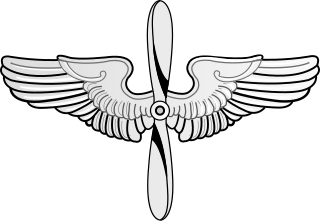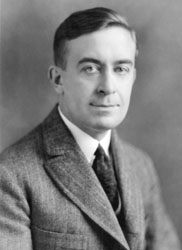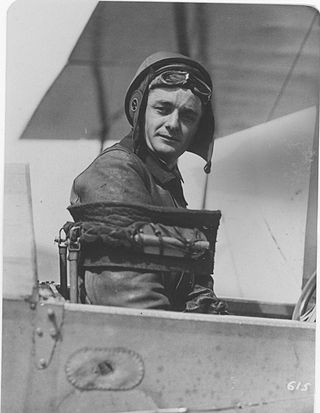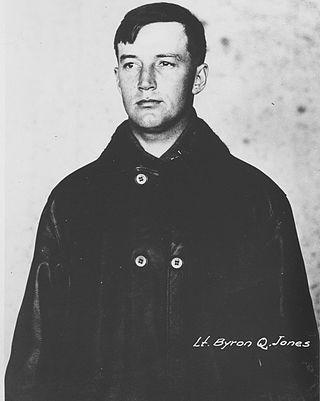Related Research Articles

Wilbur Wright Field was a military installation and an airfield used as a World War I pilot, mechanic, and armorer training facility and, under different designations, conducted United States Army Air Corps and Air Forces flight testing. Located near Riverside, Ohio, the site is officially "Area B" of Wright-Patterson Air Force Base and includes the National Museum of the United States Air Force built on the airfield.

The United States Army Air Service (USAAS) was the aerial warfare service component of the United States Army between 1918 and 1926 and a forerunner of the United States Air Force. It was established as an independent but temporary branch of the U.S. War Department during World War I by two executive orders of President Woodrow Wilson: on May 24, 1918, replacing the Aviation Section, Signal Corps as the nation's air force; and March 19, 1919, establishing a military Director of Air Service to control all aviation activities. Its life was extended for another year in July 1919, during which time Congress passed the legislation necessary to make it a permanent establishment. The National Defense Act of 1920 assigned the Air Service the status of "combatant arm of the line" of the United States Army with a major general in command.

Air Materiel Command (AMC) was a United States Army Air Forces and United States Air Force command. Its headquarters was located at Wright-Patterson Air Force Base, Ohio. In 1961, the command was redesignated the Air Force Logistics Command with some of its functions transferred to the new Air Force Systems Command.

Mitchel Air Force Base, also known as Mitchel Field, was a United States Air Force base located on the Hempstead Plains of Long Island, New York, United States. Established in 1918 as Hazelhurst Aviation Field #2, the facility was renamed later that year as Mitchel Field in honor of former New York City Mayor John Purroy Mitchel, who was killed while training for the Air Service in Louisiana.

Thomas DeWitt Milling was a pioneer of military aviation and a brigadier general in the U.S. Army Air Corps. He was the first rated pilot in the history of the United States Air Force.

The Aeronautical Division, Signal Corps (1907–1914) was the first heavier-than-air military aviation organization in history and the progenitor of the United States Air Force. A component of the U.S. Army Signal Corps, the Aeronautical Division procured the first powered military aircraft in 1909, created schools to train its aviators, and initiated a rating system for pilot qualifications. It organized and deployed the first permanent American aviation unit, the 1st Aero Squadron, in 1913. The Aeronautical Division trained 51 officers and 2 enlisted men as pilots, and incurred 13 fatalities in air crashes. During this period, the Aeronautical Division had 29 factory-built aircraft in its inventory, built a 30th from spare parts, and leased a civilian airplane for a short period in 1911.

The Aviation Section, Signal Corps, was the aerial warfare service of the United States from 1914 to 1918, and a direct statutory ancestor of the United States Air Force. It absorbed and replaced the Aeronautical Division, Signal Corps, and conducted the activities of Army aviation until its statutory responsibilities were suspended by President Woodrow Wilson in 1918. The Aviation Section organized the first squadrons of the aviation arm and conducted the first military operations by United States aviation on foreign soil.

McCook Field was an airfield and aviation experimentation station in Dayton, Ohio, United States. It was operated by the Aviation Section, U.S. Signal Corps and its successor the United States Army Air Service from 1917 to 1927. It was named for Alexander McDowell McCook, an American Civil War general and his brothers and cousins, who were collectively known as "The Fighting McCooks".

Frank Purdy Lahm was an American aviation pioneer, the "nation's first military aviator", and a general officer in the United States Army Air Corps and Army Air Forces.
Frederick Erastus Humphreys was one of the original three military pilots trained by the Wright brothers and the first to fly solo.

U.S. Air Force aeronautical ratings are military aviation skill standards established and awarded by the United States Air Force for commissioned officers participating in "regular and frequent flight", either aerially or in space, in performance of their duties. USAF aeronautical badges, commonly referred to as "wings" from their shape and their historical legacy, are awarded by the Air Force in recognition of degrees of achievement and experience. Officers earning these badges and maintaining their requirements are classified as rated officers and receive additional pay and allowances.

The Aeronautical Systems Center (ASC) is an inactivated Air Force product center that designed, developed and delivered weapon systems and capabilities for U.S. Air Force, other U.S. military, allied and coalition-partner warfighters. ASC formed in 1961, and over its lifetime it managed 420 Air Force, joint and international aircraft acquisition programs and related projects; executed an annual budget that reached $19 billion and employed a workforce of more than 11,000 people located at Wright-Patterson Air Force base and 38 other locations worldwide.

Alfred Victor Verville was an American aviation pioneer and aircraft designer who contributed to civilian and military aviation. During his forty-seven years in the aviation industry, he was responsible for the design and development of nearly twenty commercial and military airplanes. Verville is known for designing flying boats, military racing airplanes, and a series of commercial cabin airplanes. His planes were awarded with the Pulitzer Speed Classic Trophy in 1920 and 1924.

The Verville-Sperry R-3 was a cantilever wing racing monoplane with a streamlined fuselage and the second aircraft with fully retractable landing gear, the first being the Dayton-Wright RB-1. In 1961, the R-3 racer was identified as one of the "Twelve Most Significant Aircraft of all Time" by Popular Mechanics magazine. In 1924, an R-3 won the Pulitzer Trophy in Dayton, OH.

Virginius Evans Clark was an officer in the United States Army, a military aviation pioneer, and a World War I engineer. Clark designed the 1922 Clark Y airfoil used by many early aircraft.

Townsend Foster Dodd was the first commissioned US Army aviator. As a University of Illinois graduate with a Bachelor of Science in electrical engineering, he joined the Coast Artillery Corps and shortly thereafter became an aviator in the US Army Air Service. Dodd sat on many boards of review during the service's infancy and was one of the members who condemned pusher planes in favor of tractors. He served with General John Pershing on the Mexican Border where he set records for endurance flying. During World War I he was first assigned as the aviation officer of the American Expeditionary Force in 1917. He was later replaced by Colonel Billy Mitchell and was reassigned to the Bolling Mission.

Byron Quinby Jones was a pioneer aviator and an officer in the United States Army. Jones began and ended his career as a cavalry officer, but for a quarter century between 1914 and 1939, he was an aviator in the various organizations that were the Army's air arm. He appeared to be on track in the 1930s to becoming one of the senior commanders of the Air Corps, but his views on the role of airpower diverged from those of his Air Corps peers and he returned to the Army's ground forces at the beginning of World War II.

The Bird of Paradise was a military airplane used by the United States Army Air Corps in 1927 to experiment with the application of radio beacon aids in air navigation. On June 28–29, 1927, the Bird of Paradise, crewed by 1st Lt. Lester J. Maitland and 1st Lt. Albert F. Hegenberger, completed the first flight over the Pacific Ocean from the mainland, California, to Hawaii. For this feat the crew received the Mackay Trophy.

Harold Ross Harris was a notable American test pilot and U.S. Army Air Force officer who held 26 flying records. He made the first flight by American pilots over the Alps from Italy to France, successfully tested the world's first pressurized aircraft, was the first airman to safely escape from an aircraft by "bailing out" using a free-fall parachute. In his civilian career he helped create the first aerial application "crop dusting" business, and later retired as vice-president of Pan American Airways.
References
- ↑ Maurer, Maurer (1978), "The Final Report and a Tactical History" (PDF), The U.S. Air Service in World War I, vol. One, Washington, D.C.: Officer of Air Force History, Headquarters USAF, pp. 53–54, archived from the original (PDF) on 2013-09-27, retrieved 2014-07-07
- ↑ "All-aero".
- 1 2 "Records of the Army Air Forces [AAF]" (weblist). NARA. Retrieved 2013-08-19.
- Acquisition Management in the United States Air Force and its Predecessors. Accessed 22 September 2008.
- Lineage and Commanders of Aeronautical Systems Center. Accessed 22 September 2008.